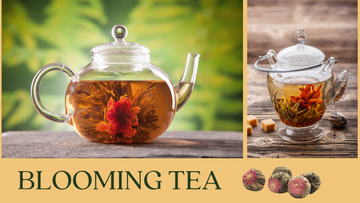
The color white has long been associated with qualities of purity and innocence, evoking a sense of serenity and simplicity. Within the realm of teas, the significance of white goes beyond aesthetics. Regarded as one of the most delicate teas, white tea introduces enthusiasts to an unparalleled experience that elevates it far beyond its unassuming beginnings.
The Origins and History of White Tea
White tea traces its roots back to the Fujian province of China, where it was first discovered and cultivated. Legend has it that white tea was accidentally discovered during the Song Dynasty (960-1279 AD) when tea leaves were left to dry in the sun after the processing of green tea was complete. This gentle method of processing helped to preserve the natural appearance and flavor of the tea leaves, giving rise to what we now know as white tea.
The Production Process
White tea's unique character is a result of its minimally processed leaves. Unlike other types of tea, white tea is made from the young, tender leaves and buds of the tea plant (Camellia sinensis), which are plucked during the early spring. The leaves are then withered under natural sunlight or indoor conditions to reduce moisture content.

After withering, the leaves are minimally processed to preserve their delicate flavor and appearance. They may undergo a light oxidation process before being gently dried. The lack of rolling and excessive processing helps maintain the tea's natural color, flavor, and nutritional content.
Varieties of White Tea
There are several varieties of white tea, each with its own unique characteristics:
Silver Needle (Bai Hao Yin Zhen): This highly sought-after variety consists of only the young buds covered in silvery-white down. It produces a subtle, sweet, and floral infusion.
White Peony (Bai Mu Dan): Comprising both buds and young leaves, White Peony offers a slightly bolder flavor profile with hints of fruitiness and a light body.
Tribute Eyebrow (Gong Mei): Made from leaves that are slightly more mature than those used for Silver Needle and White Peony, Tribute Eyebrow has a fuller flavor with a gentle earthiness.
Health Benefits of White Tea
White tea is celebrated not only for its delicate flavor but also for its potential health benefits. Rich in antioxidants, white tea may help protect cells from oxidative stress and reduce the risk of chronic diseases. Some potential benefits include:
Antioxidant Support: The polyphenols and catechins present in white tea contribute to its antioxidant properties, which can help neutralize harmful free radicals in the body.
Skin Health: The antioxidants in white tea may promote healthy, youthful-looking skin by combatting oxidative damage and supporting collagen production.
Cardiovascular Health: Regular consumption of white tea may contribute to heart health by helping to lower cholesterol levels and reduce blood pressure.
Weight Management: White tea has been associated with potential effects on metabolism and fat oxidation, making it a potential ally in weight management efforts.
Brewing the Perfect Cup
To fully appreciate the delicate nuances of white tea, proper brewing is essential. Here's a simple guide to brewing the perfect cup:
- Water Temperature: Heat water to around 175-185°F (80-85°C) to avoid scalding the delicate leaves.
- Tea Leaves: Use about 2-3 grams of white tea leaves per 8 ounces of water.
- Steeping Time: Steep the tea for 4-5 minutes to allow the flavors to gently infuse.
- Multiple Infusions: White tea leaves can often be steeped multiple times, with each infusion revealing different layers of flavor.




